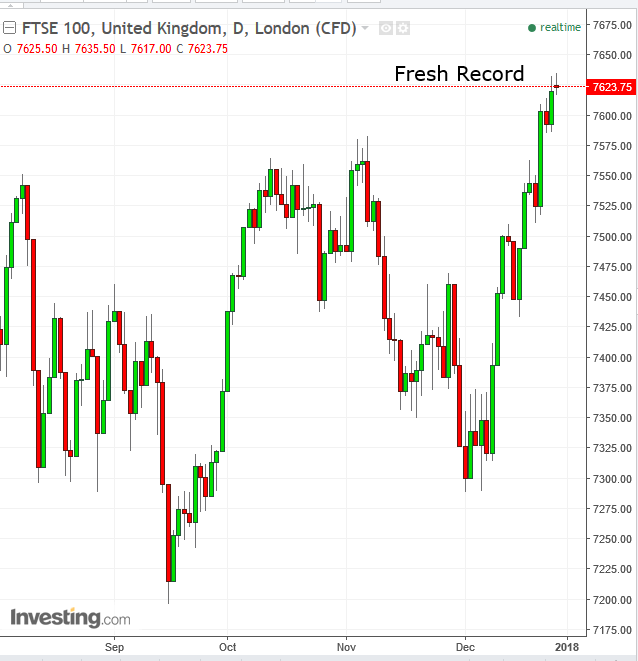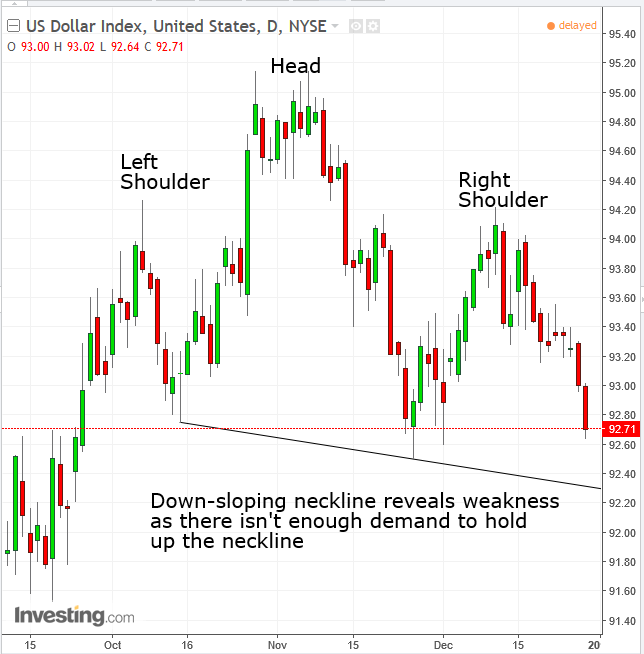Key Events
US equities crawled higher yesterday, ending a two-day slump. Though data released by the Conference Board showed consumer confidence reached 122.1 in December, slightly below the 17-year high of 128.6 registered in November, American consumers remain upbeat about the economy for three reasons:
- A low unemployment rate of 4.1 percent for two consecutive months – October and November – is the lowest since February 2001; That's 17 years (the same period for the consumer confidence level), as jobs grew for 86 straight months, the longest expansion on record since 1939.
- A record breaking string of stock market new highs, which according to Allianz’s Mohamed El-Erian causes many to ignore signals for caution that might be gleaned from flat yields.
- Tax reform
Global Financial Affairs
Stocks in Asia fell this morning on the dearth of any leading indicators from the listless US session, but rebounded at the close to advance. Japanese shares, however, bucked the recovery trend, on profit-taking after an exceptional year. The TOPIX, just 0.12 percent from its highest level since 1990, retreated and the MSCI Asia Pacific Index—just half a percentage point away from the record it reached in November—moved higher. The weak dollar, compounded by global economic expansion, boosted emerging markets, including Asia.
Stocks in Europe failed to maintain the Asian rally. The STOXX Europe 600 slumped, led by technology shares; miners extended gains on rising oil and raw materials.

Ironically, the UK's FTSE 100, albeit indirectly the focus of EU aggression via Brexit negotiations, hit a fresh record high.
US indices on the other hand appear to be finishing the year on a muted note, in contrast to the more exuberant activity displayed throughout 2017, including during the week before the holidays when Republicans passed the biggest tax overhaul in 30 years which sent markets soaring. The Dow experienced its longest streak on record, and its largest annual gain since 2013.
Investor focus will likely now to turn to corporate earnings forecasts for next year in the hope that continued economic growth will pick up the slack in order to drive shares higher when central banks around the world tighten accommodation.

The dollar is falling hard for a third day. It's down 0.29 percent and trading at the very bottom of its range. Yesterday’s consumer confidence release did nothing for the dollar or Treasury yields.
The greenback fell 0.27 percent to its lowest since December 1. Should the dollar lock in this decline—and even if it would pare losses and move back up to 92.79—it would be the lowest close since September 25.

Concurrently, the yield on the 10-year Treasury remained depressed, below 2.5 percent, after dropping yesterday by seven basis points, the most since September, demonstrating that investors don’t believe they'll get a better yield—based on the interest rate—anytime soon.
The weak dollar has upset market structure as well as caught institutions off guard, in a year in which policy makers have increased the rate three times and started descaling the balance sheet. Interpretations regarding what's really going on, as with so many things in life, are often colored by a viewer's preconceived bias.
- A bearish view would conclude that investors have no faith in a sustained US economic recovery, spurring a 9.5 percent selloff in the global reserve currency in 2017, in which 9 of its 12 months have been painted as red for the USD.
- A bullish view would conclude that the dollar selloff does not reflect a diminished outlook for a US recovery but rather consensus for the faster pace of a global recovery, leading other major central banks to enter a tightening cycle, strengthening their local currencies versus the dollar.
Both views appear logical, don’t they? Perhaps, then, we can find another yardstick for the true underlying market outlook, this one largely driven by institutions and smart money.
As we've been noting throughout the year, pressure on longer-dated yields seems odd in a year when the Fed increased rates three times, with an outlook for three more hikes next year, and Goldman Sachs even predicts four. Why would investors lock themselves into current yields when they can expect that yields will rise? Rates increases in other countries may weaken the dollar, which is traded in tandem with other currencies, but it does not explain why investors are increasing demand for Treasuries with current yields.
As mentioned above, Allianz chief economic adviser Mohamed El-Erian disregards the flat yield curve—in which longer-dated yields are the same as shorter-dated yields, suggesting investors don’t expect yields to go up—generally a leading indicator signaling an economic downturn, as smart money is ahead of the curve. He cites eight reasons why he thinks this time is different.
We disagree, considering that even yesterday’s extremely bullish data on consumer confidence did absolutely nothing for yields and the dollar. It certainly looks like even the biggest tax overhaul in decades can’t seem to convince investors to buy into the greenback.

With less than two trading days left to the year, the dollar is set for its worst performance since 2003, with an annual decline of 9 percent.

In a mirror image, it's been the euro’s best year over the same period. The single currency yesterday reached a 3.5 week high of $1.1904, on track to gain over 13 percent in 2017. As of 10:24 PM Wednesday, the dollar traded at 1.1910, the exact same as its August monthly close, its highest since December 2014.
The weaker dollar boosted currencies and commodities.
As the euro climbed to the highest in more than three months, core bond yields in Europe ticked higher. The yen strengthened against the dollar for a second straight year. The Bloomberg Commodity Index extended its longest streak in more than 12 years as oil, gold and copper all posted gains.

Even versus a weaker dollar, Bitcoin, dropped 30 percent from the December 18 record high, as South Korea, in an effort to combat speculation, announced exchange closures are possible, to combat speculation, particularly in the form of pyramid schemes and drug crimes for fast cash. Hopes of a bottom at $15,000 have imploded after the cryptocurrency fell nearly another 10 percent today, below $13,600.
Up Ahead
- US trade figures are due later today, as are EIA crude oil inventories.
Market Moves
Stocks
- The Stoxx Europe 600 Index declined 0.1 percent as of 8:32 London time (3:32 EST).
- The UK’s FTSE 100 increased less than 0.05 percent to its highest point on record.
- Germany’s DAX decreased 0.2 percent to the lowest in more than three weeks.
- S&P 500 Futures rose 0.1 percent.
Currencies
- The Dollar Index sank 0.33 percent to the lowest in more than three weeks on the largest decrease in more than two weeks.
- The euro jumped 0.4 percent to $1.1941, the strongest in almost 14 weeks on the biggest increase in more than a week.
- The British pound climbed 0.4 percent to $1.3451, the strongest in three weeks on the largest climb in more than a week.
- The Japanese yen jumped 0.5 percent to 112.78 per dollar, the strongest in more than a week on the biggest increase in more than two weeks.
Bonds
- The yield on 10-year Treasuries rose two basis points to 2.43 percent after sliding six basis points on Wednesday
- Germany’s 10-year yield rose two basis points to 0.41 percent, the largest rise in more than a week.
- Britain’s 10-year yield rose one basis point to 1.185 percent, the biggest rise in more than a week.
Commodities
- West Texas Intermediate crude gained 0.3 percent to $59.82 a barrel.
- Gold gained 0.4 percent to $1,292.27 an ounce, hitting the highest in a month with its seventh consecutive advance.
- Copper rose 0.8 percent to $3.31 a pound, reaching the highest in more than four years on its 16th consecutive advance.
